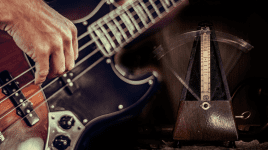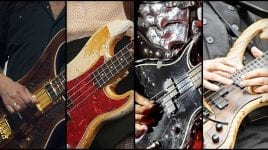
Providing only the root notes of a chord on the bass can be perfect for some styles of music. Thunderstruck by AC/DC consists ultimately of nothing more than these mono-rhythmic root notes, which give the song stability and at the same time a driving force. But there is much more that you can tickle out of your bass if you’re not a “one-note warrior”. With a bit of harmony and some rhythm skills, bass players take their bass lines to a new level. Ultimately, it’s about letting the song and the melody breathe noticeably more. Below you will find bass line tips from Nathan Navarro…
1. Pimp up basic notes with leading tones

Let’s take a couple of sixteenth notes and brew a straight bass line. We move over a guitar chord progression changing from A minor to D minor. Immediately, we should not think about these two tones, instead, we use different nonchord tones for the chord changes. For example, try to use the G or the C as leading tones, more tones are conceivable to season the bass line tastefully. The blues and rock character is preserved with sounds from the pentatonic scale.
Should it be more melodic, you use the traditional Gregorian mode in the leading tone. There are many ways to get from one chord to the next. Incidentally, Paul McCartney of The Beatles has used such melodic bass movements splendidly; it was his trademark.
2. Add extended chord tones

What’s important to bassists is to decode the harmonies. As an example, let’s play the A minor chord on guitar with the notes A, C, E. We add another note to the minor chord – the F – and thereby make an Am6 – a four-note chord. If we play an F# on the bass now, the chord transforms into a Fmaj7 as if by magic. While an A minor is a fairly clean chord, the F in the bass provides a completely new, somewhat round sound character.
You can also experiment by reversing the chord structure, which is especially appealing in four notes. In music theory this is called an enharmonic confusion, meaning that the stacked thirds and modal tones of a chord do not begin with the fundamental tone. The bassist doesn’t have to play the root or the fifth. It becomes much more diversified when s/he plays along the third, the sixth or the seventh.
3. Syncopation & Space – emphasize the unstressed

Another interesting variant is to work with syncopation and space, a question of rhythm. The bass player sometimes needs to disconnect from the rhythm structure of the rest of the band. When s/he plays in the spaces between notes, we can get some striking results!
Syncopation means that the accent pattern is broken up by playing on unaccented beats. For a better understanding, let’s take a simple example: you play in a 4/4 cycle where the emphasized counts are the one, two, three and four. As a bassist, you can either join in monotonously or make yourself a rhythmic outlaw and break the pattern. You start with your line, for example, on the two-and beat and work with accented tones.
The particular attraction is that the rest of the band plays straight even while the bass player fills gaps, making everything mesh into a larger whole. It’s worth a try, you’ll see.
4. Double it up at the right moment

The guitarist plays the hook line, the bassist provides the rhythmic foundation with very even eighth and sixteenth notes, keeping the framework streamlined. A special, and surprising, accent can be achieved if the bassist doubles the riffs of the guitarist during certain sections of the song, playing a few notes identically, and then returning directly to the groove pattern.
That is to say, you do not play in unison permanently with the guitarist, instead only short parts, such as the last half measure of a bar. Only leave the groove during certain moments and vary these doubled inserts irregularly to please the listener’s ear. Experimentation is required here to get the right effect or mood.
Watch Nathan Navarro as he teaches us a few bass line tips with the help of our Kris…
You are currently viewing a placeholder content from Youtube. To access the actual content, click the button below. Please note that doing so will share data with third-party providers.
These techniques can, and should, be combined with each other. Remember that as a bassist you are the leader in the low-frequency range, so make sure that the bass lines do not become too hectic or overly busy. This would probably cause the song framework to wobble or become muddy. Just rely on your instincts, then you can develop freely. Have fun experimenting!
8 comments
Leave a Reply
You are currently viewing a placeholder content from Facebook. To access the actual content, click the button below. Please note that doing so will share data with third-party providers.
More InformationYou are currently viewing a placeholder content from Instagram. To access the actual content, click the button below. Please note that doing so will share data with third-party providers.
More InformationYou are currently viewing a placeholder content from X. To access the actual content, click the button below. Please note that doing so will share data with third-party providers.
More Information





Vladimirs Berezins says:
Ļoti labi padomi prieks !
Steve says:
Am6 has a f# not an f, back to music class for you.
Joe says:
Thank you sir!
Michael Cohen says:
So good
Steve says:
Are you not embarrassed Joe? I mean, learners will be looking at this are you’re wrong about something so simple? Thomann, my god get a grip.
Steve says:
Dear god, your wrong about f# making it an Fmaj7 chord too, there’s no f# in an Fmaj7 chord. Do you want to have some music lessons with me lol?
John Rowlands says:
Great site. As a novice I can’t wait to catch up.
David hebert says:
Steve why don’t you get a life “please”